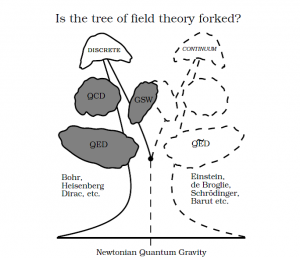Physics is a very peculiar subject. When it changes, it does so radically in concept. However, the difference in results is barely perceptible.
Quantum mechanics is close to a hundred years old now. However, the classical theories of point and continuum mechanics are fine for most applications. How can the conceptual structure of a theory be so different and the results so similar?
For instance, under quantum theory we are supposed to believe in wave-particle duality. Bohr introduced the idea of complementarity to support his assertion that things are just too weird down there to understand. However, I wonder if this was just a ruse.
In 1926 there were two contending pathways forward: the continuum wave-mechanics of Schrödinger; and the discrete matrix mechanics and transition theory of Heisenberg. Of course, Dirac was able to demonstrate how they might be viewed as equivalent.
The philosophy of wave-particle duality has potentially obscured an important reality. While the two theories may be mathematically equivalent, due to the Dirac transformation theory, they are not physically equivalent as pictures. They suggest different ideas.
The wave-mechanics of Schrödinger leads the mind in different directions than does the matrix mechanics of Heisenberg. What we think of as natural in one picture can seem unnatural in the other picture.
For example, particle physics conceives of all particles as point-like and subject to creation and destruction via quantum transitions.
That picture is rather unnatural in the Schrödinger scheme of things. The wave equation has no inherent jumpiness to it at all. It is completely deterministic. Moreover, when one thinks this way the usual matrix elements for atomic transitions become rather obvious derivates of classical charge densities. It is a just a small variation on the classical theories of the dielectric due to H.A. Lorentz.
In the Heisenberg scheme, the transition element is just plucked from thin air. It has no obvious connection to the previous theory of classical dielectrics. Indeed, students are mercilessly beaten if they should dare to even suggest such a thought!
The lesson for me in all this can be stated rather briefly.
Suppose Schrödinger and de Broglie were right and we should treat matter waves as real stuff and not probability amplitudes?
Where would that take us? What would become of wave-particle duality? What is logical?
One thing seems very clear to me… There would be no particles.
In this picture, everything is a wave, albeit one which can be dynamically localized. The electron, as a wave, has an extent, and this is determined by the prevailing interactions. These can naturally be of two kinds:
1) mutual interactions
2) self-interactions
In the detailed development of quantum chemistry we can say a lot, in detail, about the first class of interactions. They are entangling, and so ensure that the waves in question must exist in configuration space. In short, entanglement is the normal state of affairs.
However, about the second kind of interaction we do not actually know very much. What we do know is that if you break wave-particle duality in favor of particles then you need to introduce a vacuum, along with particle creation and destruction. This is the basis for Quantum Field Theory and the reason why most particle physicists habitually refer to a wave-function of a single coordinate as a classical field.
Within this way of thinking, it is necessary to turn this classical field into an operator and then speak the language of particles.
Of course, with that goes another problem. One needs to figure out how to obtain finite answers for the electron self-energy and the related vacuum polarization effects. One has also bought into an infinite zero-point energy and a host of other technical difficulties.
On the other had, if we break wave-particle duality in favor of waves things look different. In that case, it is easy to get a finite self-energy term and there is no vacuum, nor any pesky zero-point energy. However, there are still meaningful problems. The main one is to get a stable bound structure for the electron since the static Coulomb field is repulsive. This would seem to involve the need to introduce an auxiliary field.
The purpose of this all too brief survey is to highlight one simple fact. Waves and particles are most definitely not equivalent as ideas for theory construction. When you attempt to build a theory based upon waves in configuration space then many things look different:
1) particles are no longer point-like and must therefore be dynamic entities
2) quantum fields are simply entangled wave-functions in configuration space
3) the reconciliation of mutual-interactions with self-interactions is incompletely understood
It is the last item which presents the major difficulty. Quantum Field Theory does not go over into this new regime in unmodified form. However, there is a new freedom gained to treat certain questions differently. For instance, pair processes and indeed all higher energy resonances, as seen in particle accelerator experiments, would need to be differently interpreted as resonant wave phenomena.
If I had to make a bet for the next hundred years in physics I would take these positions:
Waves: Long
Particles: Short
de Sitter Gravity: Long
String Theory: Short
Schrödinger: Long
Heisenberg: Short
Non-Linear Field Theories: Long
Linear Field Theories: Short
Einstein on Determinism: Long
Bohr on In-determinism: Short
It seems to me that these are all in fact the exact same bet.
When you change a theory, you need to make it self-consistent as well as empirically accurate. Strings go away because the reason for them is gone: the particle is really a wavy quasi-particle. The other bets relate to the physical consistency of real matter waves.
Of course, these are all quoted at very long odds right now.
However, they are my personal bets.
In a world obsessed with the very latest: everything old is new again.
 Nicolas Bourbaki: A Symphony of Horror
Nicolas Bourbaki: A Symphony of Horror Jolly Roger of Calico Jack Rackham
Jolly Roger of Calico Jack Rackham


